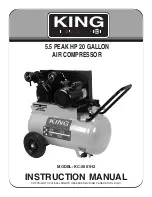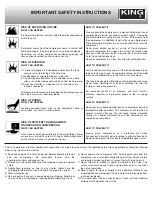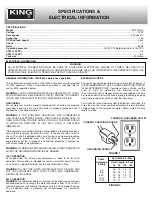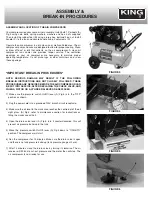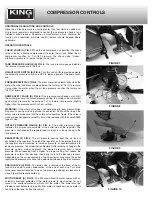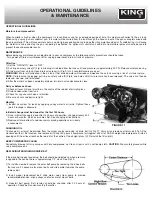
IMPORTANT SAFETY INSTRUCTIONS
RISK OF EXPLOSION OR FIRE
WHAT CAN HAPPEN
It is normal for electrical contacts within the motor and pressure
switch to spark.
If electrical sparks from the compressor come in contact with
flammable vapors, they may ignite, causing fire or explosion.
Restricting any of the compressor ventilation openings will
cause serious overheating and could cause fire.
HOW TO PREVENT IT
Always operate the compressor in a well ventilated area free of
combustible materials, gasoline or solvent vapors. If spraying
flammable materials, spray material at least 20 feet away from
the compressor. An additional length of hose may be required.
Store flammable materials in a secure location away from the
compressor.
Never place objects against or on top of the compressor.
Operate compressor in an open area at least 18 inches away
from any wall or obstruction that would restrict the flow of fresh
air to the ventilation openings.
Operate compressor in a clean, dry and well ventilated area.
RISK OF BURSTING
WHAT CAN HAPPEN
1. Failure to properly drain condensed water from the tank,
causing rust and thinning of the steel tank.
2. Modifications or attempted repairs to the tank.
3. Unauthorized modifications to the unloader valve, safety
valve or any other components which control tank pressure.
4. Excessive vibration can weaken the air tank and cause
rupture or explosion.
Attachments & Accessories; Exceeding the operating pressure
of air tools can cause them to explode.
HOW TO PREVENT IT
Drain tank daily or after every use. If the tank developes a leak,
replace tank or get a new air compressor. Never drill into, weld
or make any modifications to the tank or its attachments.
The tank is designed to withstand specific operating pressures.
Never make adjustments or parts substitutions to alter the
factory set operating pressures.
For essential control of air pressure, you must install a
pressure regulator and pressure gauge to the air supply
system.
RISK OF BURNS
WHAT CAN HAPPEN
Touching exposed metal such as the compressor head or
outlet tubes, can result in serious burns.
HOW TO PREVENT IT
Never touch any exposed metal parts on compressor during or
immediately after operation. The compressor will remain hot
several minutes after use. Do not reach around protective
shrouds or attempt maintenance until the compressor has
cooled down completely.
RISK OF PROPERTY DAMAGE WHEN
TRANSPORTING COMPRESSOR
WHAT CAN HAPPEN
Oil can leak or spill and could result in fire or breathing hazard,
serious injury or death can result. Oil leaks will damage carpet,
paint or other surfaces in vehicules or trailers.
HOW TO PREVENT IT
Always place compressor on a protective mat when
transporting to protect against damage to vehicule from leaks.
Remove compressor from vehicule immediately apon arrival.
1) Read and understand instruction manual before attempting to install
and use compressor. Be thoroughly familiar with the
operational controls and proper use.
2) All electrical and safety codes must be followed to ensure operator
safety.
3) Applications requiring air free of oil or water should have the
appropriate filters/water traps installed in the pressure system.
4) Wear safety glasses.
5) Do not operate if any part is damaged during shipping, handling or
use, have the part replaced or repaired before attempting to use.
6) Never operate the compressor with the belt guard removed, this
compressor can start automatically without warning. Personal injury
or property damage could occur from contact with moving parts.
7) Never attempt to modify or adjust the ASME safety valve. The
safety valve must be kept clean and free from paint or any other
type of accumulation.
8) Never attempt to repair or modify air tank. Welding, drilling or any
other modification will weaken the air tank resulting in damage from
rupture or explosion.
9) Drain water from tank on a regular basis. Tanks rust from moisture
build-up which weakens the air tank.
This air compressor and other components used make up a high pressure system, the following safety rules and guidelines should be followed
when using, cleaning or servicing.

